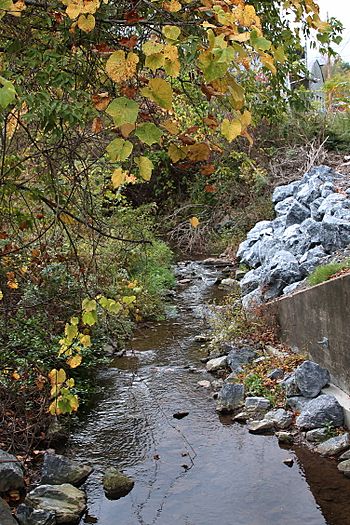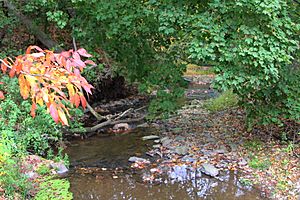Dark Run facts for kids
Quick facts for kids Dark Run |
|
|---|---|

Dark Run looking upstream near Ringtown
|
|
| Physical characteristics | |
| Main source | Union Township, Schuylkill County, Pennsylvania near Pattersonville 1,160 to 1,180 feet (350 to 360 m) |
| River mouth | Catawissa Creek in Union Township, Schuylkill County, Pennsylvania 843 ft (257 m) 40°52′56″N 76°12′23″W / 40.88217°N 76.20651°W |
| Length | 4.3 mi (6.9 km) |
| Basin features | |
| Progression | Catawissa Creek → Susquehanna River → Chesapeake Bay |
| Basin size | 4.55 sq mi (11.8 km2) |
| Tributaries |
|
Dark Run is a small stream, also called a tributary, that flows into Catawissa Creek in Schuylkill County, Pennsylvania, in the United States. It's about 4.3 miles (6.9 km) long and runs through Union Township. The area of land that drains water into Dark Run, called its watershed, is about 4.55 square miles (11.8 km2).
This stream is special because it's known as a High-Quality Coldwater Fishery. This means its water is cold and clean enough for fish that need cool temperatures to live. It's also a Class D Wild Trout Waters, which means wild trout live here naturally. You can find eight different kinds of fish in Dark Run. The land around the stream is mostly made of a rock type called the Mauch Chunk Formation, and the main soil is Leck Kill soil. Dark Run also has several smaller streams that flow into it, but they don't have official names.
Contents
Where Does Dark Run Flow?
Dark Run starts in Union Township, Schuylkill County, Pennsylvania. This is just west of a small community called Pattersonville. The stream first flows north for a short distance. Along the way, it passes through a pond.
Then, Dark Run turns east and goes through another pond. After that, it changes direction again, heading northeast. As it continues, two unnamed smaller streams join it. The stream then turns north-northeast and cuts through a ridge, which is like a long, narrow hill.
On the other side of the ridge, another unnamed stream adds to Dark Run. The stream then passes through the edge of Ringtown, Pennsylvania before returning to Union Township. It keeps flowing north-northeast and cuts through another ridge. Finally, it winds its way northeast for about a mile. Dark Run then meets Catawissa Creek at the border between Union Township and East Union Township, Schuylkill County, Pennsylvania.
Dark Run joins Catawissa Creek about 24.83 miles (39.96 km) before Catawissa Creek reaches its own end.
Smaller Streams Joining Dark Run
Dark Run doesn't have any named tributaries. But, it does have several smaller, unnamed streams that flow into it. The first two unnamed streams to join Dark Run are called "Trib 27590 to Dark Run" and "Trib 27589 to Dark Run."
Further along, east of Ringtown, two more unnamed streams, "Trib 27588 to Dark Run" and "Trib 27587 to Dark Run," add their water. Finally, "Trib 27586 to Dark Run" joins Dark Run not far from where it meets Catawissa Creek.
Water Quality of Dark Run
Dark Run helps make Catawissa Creek more fertile, meaning it brings in nutrients. However, the stream does get some runoff from farms. This runoff can carry things like fertilizers into the water.
Scientists have measured the water in Dark Run. About 2.66 miles (4.28 km) upstream from where it meets Catawissa Creek, the pH of the water is 7.0. This means it's neutral, not too acidic or too basic. The water also has 16 milligrams per liter of alkalinity, which helps keep the pH stable.
Closer to its mouth, about 1.71 miles (2.75 km) upstream, the pH is 7.4, which is slightly basic. The alkalinity here is higher, at 28 milligrams per liter. The hardness of the water, measured 2.66 miles (4.28 km) upstream, is 34 milligrams per liter. This tells us how many minerals are dissolved in the water.
In June 1997, measurements were taken. The air temperature near Dark Run was around 29 °C (84 °F), and the water temperature was about 17.5 °C (63.5 °F). The water's specific conductivity, which shows how well electricity passes through water (and thus how many dissolved solids are in it), was 118 umhos at one spot and 171 umhos at another.
Land and Rocks Around Dark Run
The land where Dark Run meets Catawissa Creek is about 843 feet (257 m) above sea level. Where Dark Run begins, its source, the elevation is higher, between 1,160 feet (350 m) and 1,180 feet (360 m) above sea level.
The rocks under Dark Run and all its smaller streams belong to the Mauch Chunk Formation. This rock layer is made up of different kinds of rocks like siltstone, sandstone, reddish-gray shale, and conglomerate. The soil covering the entire stream and its tributaries is called Leck Kill soil.
Dark Run is a narrow stream, only about 3.3 metres (11 ft) wide. It doesn't drop very steeply, with a gentle slope of 13.5 meters per kilometer.
Some areas around Dark Run are prone to flooding. This is especially true between its mouth and Ringtown during a 100-year flood, which is a very large flood that has a 1% chance of happening in any given year. One of its unnamed tributaries, "Trib 27588 to Dark Run," is also surrounded by flood-prone areas along its entire length.
The Dark Run Watershed
The watershed of Dark Run covers an area of 4.55 square miles (11.8 km2). Most of this watershed is located in Union Township. However, it also includes almost all of Ringtown.
You can find farmland throughout the watershed, especially in the valley where the stream flows. There are also some areas used by clubs and associations in the upper and lower parts of the stream.
Important roads in the Dark Run watershed include Rattlin Run Road, Ringtown Boulevard, Pattersonville Road, Center Street, and Main Street (the last two are in Ringtown). About 33 percent of the stream's length is within 100 metres (330 ft) of a road. A larger portion, 66 percent, is within 300 metres (980 ft) of a road, and 95 percent is within 500 metres (1,600 ft) of a road. In 1990, about 40 people lived in each square mile of the watershed.
Dark Run appears on the United States Geological Survey maps called Nuremberg and Shenandoah. It's one of the southernmost streams that flows into Catawissa Creek. There are three water sources on Dark Run in its upper parts. Other water sources are near the mouth of "Trib 27588 to Dark Run" and in the upper parts of "Trib 27587 to Dark Run."
A bridge for Farmers Road was built over Dark Run in 1960. It's a steel stringer bridge that is 26.9 feet (8.2 m) long. This bridge is currently closed.
Animals and Plants in Dark Run
The Pennsylvania Department of Environmental Protection considers Dark Run a High-Quality Coldwater Fishery. This means it's a great place for fish that need cold water. It's the only stream that flows into Catawissa Creek that is a High-Quality Coldwater Fishery but not a Class A Wild Trout Waters.
Wild trout live naturally in Dark Run. It's one of the few fertile streams in the Catawissa Creek area that supports fish life. The stream is also known as Class D Wild Trout Waters. A report from 1997 suggested that no new fish should be added to the stream. This is because the stream is quite narrow, which makes it unsuitable for stocking.
There are eight different kinds of fish living in Dark Run. These include brook trout, brown trout, and largemouth bass. However, the brown trout found here came from fish hatcheries, and the largemouth bass came from farm ponds. Scientists found eight fish species about 2.66 miles (4.28 km) upstream from the mouth and six species about 1.71 miles (2.75 km) upstream.
The total weight of wild brook trout in Dark Run is about 6.85 kilograms per hectare. This includes both smaller trout (less than 175 millimeters long) and larger ones (more than 175 millimeters long). These trout range in size from 50 to 249 millimeters long. There are about 30 smaller brook trout and 20 larger ones per kilometer of stream. Per hectare, there are about 105 smaller brook trout and 76 larger ones.
A report from 1997 mentioned that Dark Run was not a very good place for angling, or fishing with a rod and line.
Images for kids



